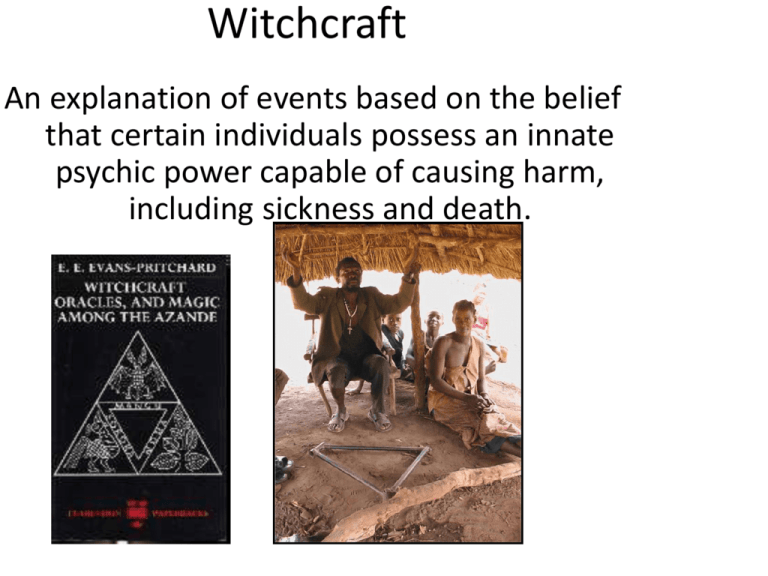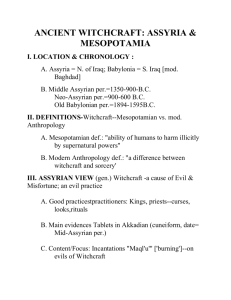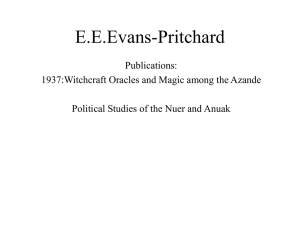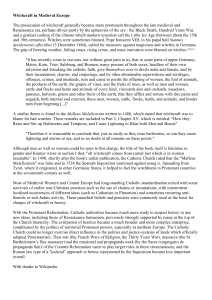Witchcraft Other Ethnographic Examples
advertisement

Witchcraft An explanation of events based on the belief that certain individuals possess an innate psychic power capable of causing harm, including sickness and death. Azande Witchcraft (1937) Witchcraft, Oracles and Magic among the Azande by Evans-Pritchard. This publication put the Azande (southern Sudan and northeastern Democratic Republic of Congo) “on the map” Anthropology-wise and made Evans-Pritchard famous. Azande Witchcraft Witchcraft or mangu exists within the body of an individual. Passed down from parent to child of the same sex (fatherson, motherdaughter). Important to the Azande is whether or not a person is consciously (or unconsciously) directing their mangu to harm someone else. Azande Witchcraft Witches are never strangers or those in a superior social position. If someone is sick, various oracles are consulted. If the oracles point to witchcraft as the source of the sickness, authorities confront the accused witch. ▪ In order to reverse the harmful affects of his/her mangu the individual will perform a ritual that involves taking water into his/her mouth and then spitting it out, therefore cooling the mangu. Mangu is blamed when an unexpected calamity occurs. The afflicted person must be the object of a witch’s hatred/jealousy/etc. in some way. Navaho Witchcraft Unlike Azande Witchcraft, this is a taboo subject not discussed in public. Witchcraft must be learned, it is not inherent. Initiation into Navaho Witchcraft, is known as initiation into Witchery Way Like the Azande, Navaho witchcraft is an antisocial and amoral behavior Witches thought to congregate in caves at night, practicing incest and cannibalism, having sexual relations with corpses and perform ritualistic killings. Navaho Witchcraft Learn Witchery Way from a relative, and it often involves killing a close relative like a sibling. Male witches are more common, as are old women. Corpse Powder (made from bones and flesh of a corpse) is used to kill their victims. Often blown into the mouth and nose of a victim while sleeping or during a ceremonial. Witches able to transform themselves and travel fast over land, usually by night. Navaho Witchcraft Identifying a witch: Follow unusual animal tracks to someone’s home. An unexplained gunshot wound, when, during the previous day, an animal had been shot fleeing the scene of the crime. If a witch is caught or captured, he or she is made to confess. If confession is not forthcoming, he or she is killed on the spot or later (presumably) by lightning. Navaho Witchcraft Witchcraft beliefs here function to: Provide a culturally acceptable manifestation of bad/amoral behavior Defines what is “bad,” which consequently defines what is “good.” Accumulation/hoarding of possessions usually indicates wealth, so encourages people to share/be modest in their possessions. Witchcraft Other Ethnographic Examples • Gnani village (Ghana). Witchraft as anti-social. Similar to Azande’s concept of mangu. Also, divination by Ordeal: – Similar example from Zimbabwe • The Sonora witches’ market (Mexico). Witchcraft as anti-social. Similar to Navajo culture’s idea of purposeful witchcraft: Witchcraft and Revival In North America, interest in and practice of witchcraft have grown over the past thirty years, often among highly educated segments of society. Contrary to popular belief, witchcraft is not concerned exclusively, or even primarily, with working evil. Witchcraft and Revival Neopaganism: pre-Christian religious traditions that have been revived and are practiced in contemporary times. A revivalistic movement. Witchcraft and Revival Wicca: Popularized by Gerald Gardner in the1950s. An amateur anthropologist who found and joined a coven of witches who he believed to be one of the last from a line of pre-Christian movements. Wicca is a polytheistic religion with varying gods and goddesses. Gender equality is stressed. Rituals and holidays often Celtic in nature. An Athame (ritual knife) and a Chalice are used in ceremonies to represent the balance of male/female. Magic is used, but only for good, unlike in Satanism. Functions of Witchcraft • Effective way for people to give a cause to misfortunes without having to shoulder blame. • Provides an outlet for feelings of hostility and frustration without disturbing the norms of the larger group. • Functions of Witchcraft mirror the functions of religion as a whole… Functions of Religion Review • Sanctions a wide range of conduct by providing notions of right and wrong. • Sets standards for acceptable behavior and helps perpetuate an existing social order. • Lifts burden of decision making from individuals and places responsibility with god. • Plays a role in maintaining social solidarity. Revitalization Movements • Social movements, often of a religious nature, with the purpose of totally reforming a society. • Ex: The Amish Cargo Cult Late 19th century-end of WWII in Melanesia • “Cargo” in Melanesia, was seen to be made by ancestors. The U.S. military had somehow intercepted the goods meant for the Melanesians. Cults emerged based on prophets who had foreseen how to control the cargo. Rituals were developed that mimicked activities of the soldiers (marching with sticks over their shoulder, marking on paper, wearing European clothes.) When these rituals failed, groups went so far as to destroy sacred objects, crops and food sources, thinking that cargo would not arrive for them as long as they had these items. Results were tragic. Cargo Cult Late 19th century-end of WWII in Melanesia • 50 years ago • Present day: acculturatio n has occurred, still keep rituals of original cult, but the mood is no longer desperate







